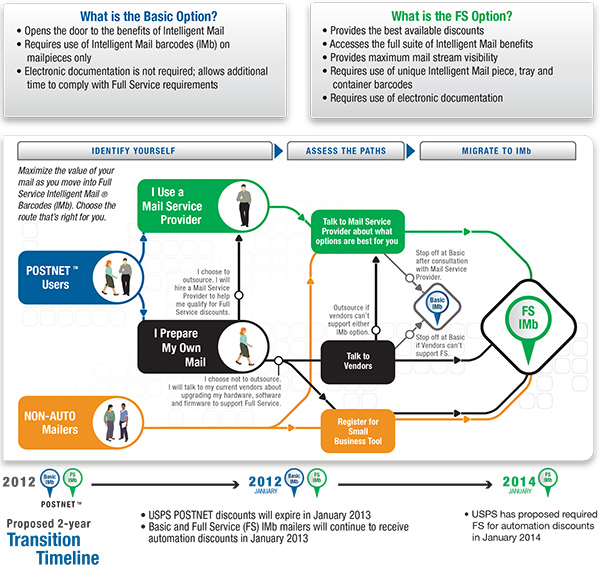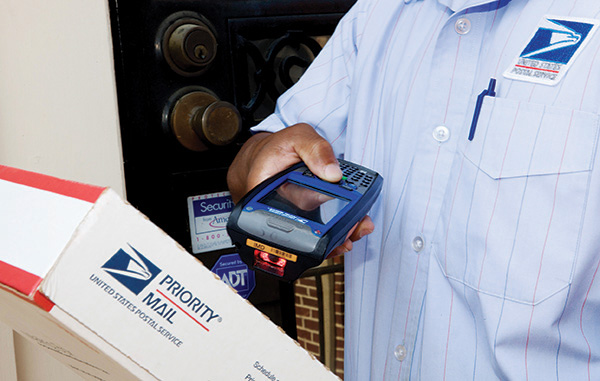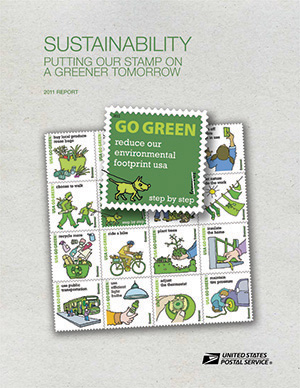Support Services
Operations Analysis, Optimization and Program Management
The Postal Service has developed a strong continuous improvement program. Managers and employees trained in operations analysis, Lean Six Sigma and Program Management apply proven tools and techniques to identify problems and their causes, develop and implement systemic improvements, and share successes.
Information Technology, Data Management and Security
The Postal Service operates one of the largest information technology infrastructures in the world. The system is closely monitored for capacity, and the Postal Service is a recognized leader in data security and privacy.
Privacy
For more than two centuries, the Postal Service has maintained a brand that customers, suppliers and employees trust to protect the privacy and security of their information, whether it is their mail or electronically stored data maintained in a computer database.
The Privacy Act of 1974 and industry best practices form the foundation for how the Postal Service collects and uses information.
The Privacy Act is a federal law designed to give individuals greater rights of access to agency records about themselves. It also gives individuals the right to amend those records, and restrict disclosure to others of personally identifiable information maintained by government agencies.
In the latest trust study conducted in 2010 by the widely recognized experts on privacy and trust at the Ponemon Institute, the Postal Service was ranked the most trusted of 75 federal agencies studied.
Since the first Ponemon study of federal agencies in 2004, the Postal Service has consistently improved its score, from 78 percent, to its 2010 highest rating of 87 percent.
Also in 2011, the Postal Service was ranked among the Top Ten Firms Most Trusted for Privacy, as it has every year since 2004, when the Ponemon Institute began conducting this equivalent survey of U.S. Businesses (http://ponemon.org/research-studies-white-papers).
To continue to achieve this high level of trust as the privacy landscape evolves, our Privacy Office keeps up with developing legal and policy decisions, new technologies and best-in-class business models and practices. It has developed a customer privacy policy and procedures based on the best business models and practices of the public and private sectors. And the office reviews USPS projects and programs to ensure Privacy Act compliance.
Freedom of Information
The Postal Service complies with the Freedom of Information Act's (FOIA) disclosure requirements. The FOIA is a federal law that provides the public with access to government information.
The only records that can't be obtained under the FOIA are those that fall under nine specific exemptions, which protect certain records from public disclosure.
It is Postal Service policy to promote transparency and accountability by adopting a presumption in favor of disclosure in all decisions involving the FOIA and to make its records available to the public to the maximum extent consistent with the public interest.
Product Visibility
One of the Postal Service's most complex strategic changes has been the product visibility program, featuring our Intelligent Mail barcode (IMb). It is integrated across our organization, from commercial mail entry to processing and delivery, and is the culmination of years of efforts to improve tracking mail pieces and mailings. The IMb is the platform for significant new opportunities for Postal managers to improve service performance and productivity while providing customers with exciting new mailing capabilities.
Intelligent Mail barcode for letters and flats
On Jan. 28, 2013, POSTNET barcodes will be retired. To continue to be eligible for automation discount prices, mailings of letter-size and flat-size mailpieces as well as postcards will need to have an IMb on each piece. Permit Reply Mail and Qualified Business Reply Mail also will be required to have an IMb.
Effective January 2014, use of full-service IMb will be required to obtain automation prices. Full-Service IMb volume has increased from 40.38 percent at the end of FY 2011 to 44.50 percent at the end of September 2012.
To support mailer adoption of full-service IMb, the Postal Service has created the Intelligent Mail small business tool. This easy-to-use tool provides an acceptance platform for small- and medium-sized mailers to prepare mailings with Intelligent Mail barcodes.
Communications about these changes have been posted in the Federal Register, and on the RIBBS website on usps.com. Also, individual communications have been sent to permit holders.
Intelligent Mail barcode for packages
Replacing the Confirmation Services barcode with the Intelligent Mail package barcode (IM®pb) for tracking parcels and for extra services is underway. The IMpb is similar to the Intelligent Mail barcode used for letter and flat size mail, but is designed specifically for parcels.
On Jan. 22, 2012, the IMpb became a requirement for PC Postage customers with a transition period extended to Jul. 31, 2012. Also, customers claiming presort or destination entry prices (except Standard Mail) must use an IMpb, legacy tracking barcode, or Extra Services barcode.
Starting Jan. 7, 2013, the IMpb will be required for all tracking and Extra Services barcodes, and all First-Class Package Services, Parcel Select, Parcel Select Lightweight, Bound Printed Matter, Media Mail and Library Mail parcels in order to claim presort and destination pricing.

Performance for Package Barcodes
Our goal is to scan every barcode that enters the system to achieve 100-percent visibility. In FY 2012, eight billion additional events have been captured over the same period last year. Between Oct. 1 and Sep. 30, FY 2012, the national scan score increased from 88.23 percent to 93.69 percent.
We have continued to invest in technology to support enhanced visibility for our
customers. In FY 2011, we deployed 4,500 ring scanners to enable enroute scanning in manual sorting operations. In FY 2012, we deployed more than 1000 additional ring scanners.
We completed upgrading our small parcel and bundle sorters to Automated Parcel and Bundle Sorters (APBS), which included improved camera technology and increased barcode read rates.
We deployed additional software enhancements to both the APBS and Automated Package Processing System (APPS) to further improve readability and ensure that package scans are delivered to our customers. These investments, combined with our operational focus on ensuring that every barcode is scanned, contributed to improvements in national scanning scores.
In the last year, we have moved from providing customers with an average of five package tracking events to up to 11 package tracking events in the Product Tracking System. All packages with USPS tracking barcodes are scanned.
Events that are most commonly available to the customer are: acceptance, dispatched to sort facility, processed through USPS sort facility (originating and destination enroute), departed USPS sort facility, arrival at Post Office, sorting complete, out for delivery and delivered.
Business Intelligence
Capturing information from Full-Service Intelligent Mail and Intelligent Mail package barcodes has created large amounts of information that can lead to the development of new opportunities in mail.
These opportunities are based in the use of business intelligence, which aims to support better decision-making. In today's fast-paced market, our product information team is developing tools to keep up with the high demand for information and supporting the critical need to make smarter, faster decisions.
Many of our small- to medium-size business partners lack access to a business intelligence environment that is easy to use and presents results that are easily consumable.
Our strategy is to build systems that can get data to customers when and how they want it. This strategy will provide a competitive market advantage for the Postal Service and long-term stability within the mailing industry.

Sustainability and Energy Management
Sustainability for USPS means supporting responsible business practices by engaging our employees, customers, suppliers and mail service providers. Our sustainability activities span the entire organization, from vehicle engineering, fleet management, facility management and supply management, to product development.
The data required to measure progress toward our sustainability goals are not available until spring of the following calendar year as part of the Annual Sustainability Report. The performance listed below is from Fiscal Year 2011:
- Reduced Scope 1, 2 and 3 greenhouse gas emissions by 7.4 percent from a 2008 baseline, toward a 20 percent reduction goal in 2020.
- Reduced total facility energy use 26 percent and goal-subject facility energy intensity (energy use per square foot) 22 percent from a 2003 baseline, towards a 30 percent goal in 2015.
- Reduced water use 25 percent from a 2007 baseline, against a 10 percent goal by 2015.
- Reduced spending on consumables 38 percent from a 2008 baseline, against a 30 percent reduction goal by 2020.
- Diverted 46 percent of solid waste from landfill to recycling.
- Increased Postal vehicle alternative fuel use by 128 percent from a 2005 baseline — to reach 159 percent by FY2015. The goal is to increase non-petroleum fuel consumption by 10 percent annually.
- Increased total Postal vehicle petroleum fuel use 8.3 percent from a 2005 baseline, against a goal to decrease petroleum fuel use 20 percent by 2015.
Although the Postal Service continues to make its delivery routes more efficient — eliminating more than 6,800 delivery routes in 2011 — petroleum use has increased. This is partially due to increases in the number of delivery points, even as mail volume goes down.
On average, 800,000 addresses were added to the delivery network annually in the last five years. In addition, most of our delivery vehicles are over 20 years old. Due to financial constraints, the Postal Service currently lacks the funds to replace this aging fleet.
Our employees are the critical component of our sustainability efforts. Employee-led Lean Green teams help reduce our carbon footprint and save money by reducing facility energy, improving water efficiency, buying fewer supplies, reducing solid waste generation and increasing recycling.
Team members come from a wide range of specialties, including operations, maintenance, supply management and human resources. Together, they implement low and no-cost projects and cultivate a conservation culture. At the end of FY 2012, there were over 850 Green teams across the nation.
The Postal Service also continuously looks to "green the mail." We have partnered with suppliers to ensure that the design and manufacturing of stamps, postcards, and Priority Mail and Express Mail boxes and envelopes use recyclable material, where possible.
Many USPS signature product lines have been evaluated by third-party eco-labeling programs. Beyond products, USPS offers services to customers to reduce their environmental footprint.
In FY 2012, USPS had several mail back programs for electronics that let customers mail their small devices back to a centralized recycler for certified disposal. USPS also launched a product carbon accounting service, USPS BlueEarth™. It is a proprietary innovation that provides business customers a carbon accounting statement for their mailing and shipping activity that can be used to complete their own greenhouse gas inventory.
 The Postal Service was the first federal agency to publish a greenhouse gas inventory verified by an independent third party. USPS has won numerous environmental honors, including the U.S. Environmental Protection Agency's (EPA) WasteWise Partner of the Year award in 2010 and 2011, the EPA's National Partnership for Environmental Priorities award in 2011 and Gold status with The Climate Registry in 2011.
The Postal Service was the first federal agency to publish a greenhouse gas inventory verified by an independent third party. USPS has won numerous environmental honors, including the U.S. Environmental Protection Agency's (EPA) WasteWise Partner of the Year award in 2010 and 2011, the EPA's National Partnership for Environmental Priorities award in 2011 and Gold status with The Climate Registry in 2011.
More detail on sustainability progress and programs in 2011 are available in the Annual Sustainability Report (http://about.usps.com/what-we-are-doing/green/report/2011/welcome.htm). Progress in 2012 will be reported in the 2012 Annual Sustainability Report. Learn more at usps.com/green.
Facilities Management
Facilities is an enabling organization that provides real estate and facilities products and services to meet the present and future needs of Postal operations. Its goal is to get optimum value from USPS facilities assets and transactions.
Real Estate Inventory |
2011 |
2012 |
|---|---|---|
Owned properties |
8,644 |
8,606 |
Owned interior square feet |
198M |
197M |
Leased properties |
24,309 |
23,998 |
Leased interior square feet |
83M |
81M |
Lease actions (Alternate quarters, new leases, and renewals) |
639 |
1,168 |
GSA/other government properties |
307 |
300 |
GSA/other government Interior square feet |
2.1M |
2.0M |
Property disposals |
43 |
49 |
Facilities Repair and Alteration |
2011 |
2012 |
|---|---|---|
New construction |
23 |
22 |
Repair and alteration projects (expense) |
59,056 |
42,489 |
Repair and alteration expense totals |
$185M |
$176M |
Repair and alteration projects (capital) |
5,848 |
3,268 |
Repair and alteration capital totals |
$335M |
$207M |
Facilities Optimization
With approximately 33,000 facilities covering in excess of 280 million interior square feet, it is critical that we make efficient use of our building portfolio. This involves analyzing the delivery and retail use within each facility to determine what is needed versus what is being used.
This NODE study analysis allows the Postal Service to systematically consolidate our delivery operations and right-size our portfolio to yield substantial operational and lease savings, as well as generating revenue through the disposal of excess properties.
To date, we have reviewed over 4,000 facilities, resulting in the identification of over 600 buildings earmarked for disposal.
Facilities Real Estate and Assets
The Real Estate and Assets group manages our entire real estate portfolio — consisting of owned and leased properties. The group develops strategies to align with USPS goals and objectives related to the disposition, acquisition and leasing of property.
Cash generating programs have produced $228 million in cash receipts from rental and sales of facilities for FY 2012. Lease expense reduction initiatives have resulted in lease termination options being negotiated to address the need for operational flexibility.
Facilities Repair and Alteration
Consistent repair of buildings is critical to assuring a healthy, safe and secure work environment. The USPS facility condition assessment program is used to identify and prioritize repair and alteration work.
The system balances self assessments and the use of field inspectors. Deficiencies are entered into a national database where they can be assigned cost estimates and a criticality rating.
Supply Management
Supply Management programs continue to achieve significant cost savings through category sourcing strategy plans, promoting competition and the use of automated tools.
We have streamlined purchasing and reduced cycle time by implementing a simplified process for getting low-cost, commercially available products and services. We also upgraded our contracting systems and developed electronic document repositories. And we have expanded our Enterprise Asset Management Solution program for automated inventory distribution and fulfillment of retail products, stamps and vehicle maintenance parts.
Financial Systems
The Postal Service completed a major software upgrade of our national financial system in FY 2012. The two-year initiative incorporated new tools, a hardware upgrade, a new operating system and the latest database platform.
The upgrade was completed while maintaining compliance with Sarbanes Oxley Act controls and other audit requirements. Benefits include simplified maintenance and facilitation of future upgrades.
The highly complex upgrade migrated eight years of data to the new software in less than 10 days. Because of the seamless implementation, Corporate Accounting encountered no issues in the first monthly close following the upgrade.